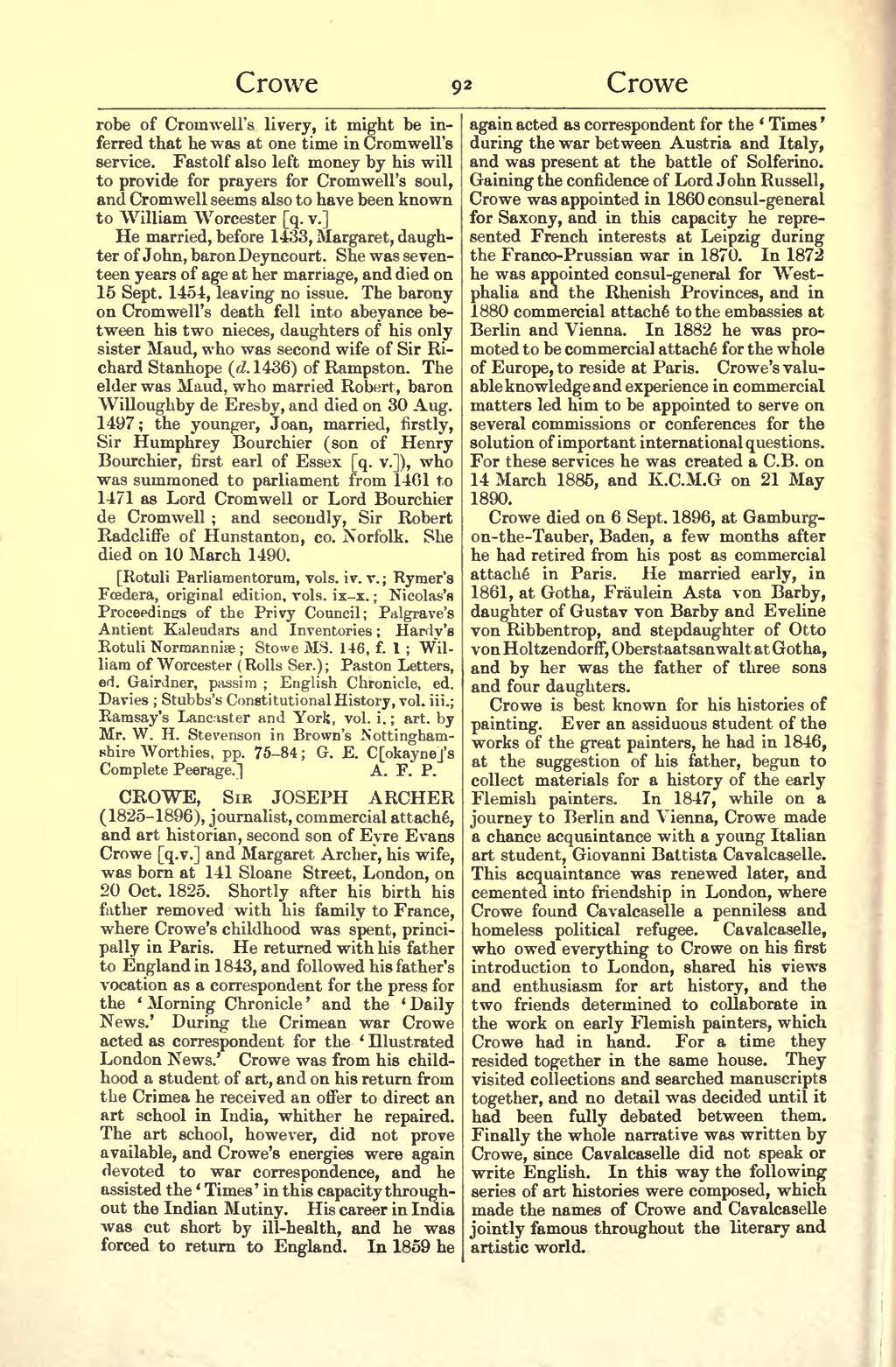robe of Cromwell's livery, it might be inferred that he was at one time in Cromwell's service. Fastolf also left money by his will to provide for prayers for Cromwell's soul, and Cromwell seems also to have been known to William Worcester [q. v.]
He married, before 1433, Margaret, daughter of John, baron Deyncourt. She was seventeen years of age at her marriage, and died on 15 Sept. 1454, leaving no issue. The barony on Cromwell's death fell into abeyance between his two nieces, daughters of his only sister Maud, who was second wife of Sir Richard Stanhope (d. 1436) of Rampston. The elder was Maud, who married Robert, baron Willoughby de Eresby, and died on 30 Aug. 1497; the younger, Joan, married, firstly, Sir Humphrey Bourchier (son of Henry Bourchier, first earl of Essex [q. v.]), who was summoned to parliament from 1461 to 1471 as Lord Cromwell or Lord Bourchier de Cromwell; and secondly, Sir Robert Radcliffe of Hunstanton, co. Norfolk. She died on 10 March 1490.
[Rotuli Parliamentorum, vols. iv. v.; Rymer's Fœdera, original edition, vols. ix–x.; Nicolas's Proceedings of the Privy Council; Palgrave's Antient Kalendars and Inventories; Hardy's Rotuli Normanniæ; Stowe MS. 146, f. 1; William of Worcester (Rolls Ser.); Paston Letters, ed. Gairdner, passim; English Chronicle, ed. Davies; Stubbs's Constitutional History, vol. iii.; Ramsay's Lancaster and York, vol. i.; art. by Mr. W. H. Stevenson in Brown's Nottinghamshire Worthies, pp. 75–84; G. E. C[okayne]'s Complete Peerage.]
CROWE, Sir JOSEPH ARCHER (1825–1896), journalist, commercial attaché, and art historian, second son of Eyre Evans Crowe [q. v.] and Margaret Archer, his wife, was born at 141 Sloane Street, London, on 20 Oct. 1825. Shortly after his birth his father removed with his family to France, where Crowe's childhood was spent, principally in Paris. He returned with his father to England in 1843, and followed his father's vocation as a correspondent for the press for the 'Morning Chronicle' and the 'Daily News.' During the Crimean war Crowe acted as correspondent for the 'Illustrated London News.' Crowe was from his childhood a student of art, and on his return from the Crimea he received an offer to direct an art school in India, whither he repaired. The art school, however, did not prove available, and Crowe's energies were again devoted to war correspondence, and he assisted the 'Times' in this capacity throughout the Indian Mutiny. His career in India was cut short by ill-health, and he was forced to return to England. In 1859 he again acted as correspondent for the 'Times' during the war between Austria and Italy, and was present at the battle of Solferino. Gaining the confidence of Lord John Russell, Crowe was appointed in 1860 consul-general for Saxony, and in this capacity he represented French interests at Leipzig during the Franco-Prussian war in 1870. In 1872 he was appointed consul-general for Westphalia and the Rhenish Provinces, and in 1880 commercial attaché to the embassies at Berlin and Vienna. In 1882 he was promoted to be commercial attache for the whole of Europe, to reside at Paris. Crowe's valuable knowledge and experience in commercial matters led him to be appointed to serve on several commissions or conferences for the solution of important international questions. For these services he was created a C.B. on 14 March 1885, and K.C.M.G on 21 May 1890.
Crowe died on 6 Sept. 1896, at Gamburg-on-the-Tauber, Baden, a few months after he had retired from his post as commercial attaché in Paris. He married early, in 1861, at Gotha, Fraulein Asta von Barby, daughter of Gustav von Barby and Eveline von Ribbentrop, and stepdaughter of Otto von Holtzendorff, Oberstaatsanwalt at Gotha, and by her was the father of three sons and four daughters.
Crowe is best known for his histories of painting. Ever an assiduous student of the works of the great painters, he had in 1846, at the suggestion of his father, begun to collect materials for a history of the early Flemish painters. In 1847, while on a journey to Berlin and Vienna, Crowe made a chance acquaintance with a young Italian art student, Giovanni Battista Cavalcaselle. This acquaintance was renewed later, and cemented into friendship in London, where Crowe found Cavalcaselle a penniless and homeless political refugee. Cavalcaselle, who owed everything to Crowe on his first introduction to London, shared his views and enthusiasm for art history, and the two friends determined to collaborate in the work on early Flemish painters, which Crowe had in hand. For a time they resided together in the same house. They visited collections and searched manuscripts together, and no detail was decided until it had been fully debated between them. Finally the whole narrative was written by Crowe, since Cavalcaselle did not speak or write English. In this way the following series of art histories were composed, which made the names of Crowe and Cavalcaselle jointly famous throughout the literary and artistic world.
